Evolution Laws of Water-Flowing Fracture Zone and Mine Pressure in Mining Shallow-Buried, Hard, and Extra-Thick Coal Seams
Abstract
:1. Introduction
2. Overview of the Study Area
2.1. Geological Condition
2.2. Aquifer Condition
3. Mine Pressure and Roadway Deformation
3.1. Simulation Scheme
3.2. Abutment Pressure
3.3. The Deformation and Stress of the Extended Open-Off Cut
3.4. The Deformation and Stress of the Maingate
4. Roof Breaking and WFFZ Development
4.1. Physical Similarity Simulation Scheme
4.1.1. Model Parameters
4.1.2. Mining and Monitoring of the Model
4.2. Roof Breaking Characteristics
4.3. Development of the WFFZ
4.4. Front Abutment Pressure
5. Engineering Practice
5.1. Working Face Weighting and Support Effect
5.2. Deformation of Maingate and Extended Open-Off Cut
5.3. Field Detection of WFFZ
5.3.1. Detection Scheme
5.3.2. WFFZ Observations
6. Conclusions
- The numerical simulation results show that the influence distance of abutment pressure and the abutment pressure peak and its position relative to the working face continue to increase as the working face advances. After the advance distance exceeds the length of the working face (155 m), the abutment pressure tends to stabilize; when the working face advances to 370 m, the front and side abutment pressure peaks are 3.9 MPa and 4.1 MPa, respectively, and are located at 10 m and 11 m in front of the working face: the corresponding zones of influence ahead of the working face reach 19 m and 21 m, respectively. The abutment pressure peak concentration factor is less than 2, which shows that the mining pressure intensity is weak. The extended open-off cut and maingate within 20 m in front of the working face are affected by mining and should be reinforced prior to mining.
- The physical similarity simulation shows that the first collapse distance of the 110501 working face is 32 m and the average collapse distance is 26 m; the development of the WFFZ can be divided into the initial development stage (advancing over the first 86.4 m), rapid development stage (advancing from 86.4 to 112 m), and the stable stage (advancing beyond 112 m); the maximum heights of the WFFZ in these three stages are 31.2 m, 53.6 m, and 83 m, respectively.
- The average weighting interval of the 110501 top coal caving face (as measured in-situ) is 26.9 m, which is similar to the collapse distance obtained from physical similarity modelling; the maximum dynamic load factor during the weighting period is 1.16. The deformation of the extended open-off cut and maingate is mainly within 20 m in front of the working face; the maximum development height of the WFFZ is 87 m according to in situ monitoring, which is close to the physical similar simulation results, but quite different from those arising from use of the empirical formula. The rock pressure in SHCSHRFB is relatively weak, which is significantly different from that of typical shallow-buried thin bedrock working faces.
Author Contributions
Funding
Institutional Review Board Statement
Informed Consent Statement
Data Availability Statement
Acknowledgments
Conflicts of Interest
References
- Xue, J.; Shi, L.; Wang, H.; Ji, Z.; Shang, H.; Xu, F.; Zhao, C.; Huang, H.; Luo, A. Water abundance evaluation of a burnt rock aquifer using the AHP and entropy weight method: A case study in the Yongxin coal mine, China. Environ. Earth Sci. 2021, 80, 417. [Google Scholar] [CrossRef]
- Qin, D.D.; Wang, X.F.; Zhang, D.S.; Guan, W.M.; Zhang, L.; Xu, M.T. Occurrence Characteristic and Mining Technology of Ultra-thick Coal Seam in Xinjiang, China. Sustainability 2019, 11, 6470. [Google Scholar] [CrossRef]
- Li, J.M.; Huang, Y.L.; Zhang, J.X.; Li, M.; Qiao, M.; Wang, F.W. The Influences of Key Strata Compound Breakage on the Overlying Strata Movement and Strata Pressure Behavior in Fully Mechanized Caving Mining of Shallow and Extremely Thick Seams: A Case Study. Adv. Civ. Eng. 2019, 2019, 5929635. [Google Scholar] [CrossRef]
- Huang, Q.X.; He, Y.P. Research on Overburden Movement Characteristics of Large Mining Height Working Face in Shallow Buried Thin Bedrock. Energies 2019, 12, 4208. [Google Scholar] [CrossRef]
- Wang, S.R.; Wu, X.G.; Zhao, Y.H.; Hagan, P. Mechanical Performances of Pressure Arch in Thick Bedrock during Shallow Coal Mining. Geofluids 2018, 2018, 2419659. [Google Scholar] [CrossRef]
- Liu, Y.J.; Qi, Q.J.; Wang, A.H. Influence of Valleys Terrain on Pressure of Fully Mechanized Working Faces in Shallow Coal Seams. Shock Vib. 2021, 2021, 8880041. [Google Scholar] [CrossRef]
- Wang, J.; Ning, J.G.; Tan, Y.L.; Hu, S.C.; Guo, W.Y. Deformation and failure laws of roadway surrounding rock and support optimization during shallow-buried multi-seam mining. Geomat. Nat. Hazards Risk 2020, 11, 191–211. [Google Scholar] [CrossRef]
- Zhao, J.; Liu, C.; Li, J. Stress field distribution and strata behavior characteristics in shallow thick coal seam mining in gully region. Caikuang Yu Anquan Gongcheng Xuebao/J. Min. Saf. Eng. 2018, 35, 742–750. [Google Scholar] [CrossRef]
- Mondal, D.; Roy, P.N.S.; Kumar, M. Monitoring the strata behavior in the Destressed Zone of a shallow Indian longwall panel with hard sandstone cover using Mine-Microseismicity and Borehole Televiewer data. Eng. Geol. 2020, 271, 105593. [Google Scholar] [CrossRef]
- Xu, Z.H.; Li, Q.S.; Li, X.B. Overburden Migration and Failure Characteristics in Mining Shallow Buried Coal Seam with Thick Loose Layer. Adv. Mater. Sci. Eng. 2020, 2020, 9024751. [Google Scholar] [CrossRef]
- Huang, Q.X.; He, Y.P.; Cao, J. Experimental Investigation on Crack Development Characteristics in Shallow Coal Seam Mining in China. Energies 2019, 12, 1302. [Google Scholar] [CrossRef]
- Gao, R.; Huo, B.J.; Xia, H.C.; Meng, X.B. Numerical simulation on fracturing behaviour of hard roofs at different levels during extra-thick coal seam mining. R. Soc. Open Sci. 2020, 7, 191383. [Google Scholar] [CrossRef] [PubMed]
- Lan, Y.W.; Gao, R.; Yu, B.; Meng, X.B. In Situ Studies on the Characteristics of Strata Structures and Behaviors in Mining of a Thick Coal Seam with Hard Roofs. Energies 2018, 11, 2470. [Google Scholar] [CrossRef]
- Gu, S.T.; Jiang, B.Y.; Pan, Y.; Liu, Z. Bending Moment Characteristics of Hard Roof before First Breaking of Roof Beam Considering Coal Seam Hardening. Shock Vib. 2018, 2018, 7082951. [Google Scholar] [CrossRef]
- Sun, Q.; Shan, C.; Wu, Z.; Wang, Y. Case Study: Mechanism and Effect Analysis of Presplitting Blasting in Shallow Extra-Thick Coal Seam. Arch. Min. Sci. 2022, 67, 381–399. [Google Scholar] [CrossRef]
- Yan, H.; Zhang, J.X.; Li, B.Y.; Zhu, C.L. Crack propagation patterns and factors controlling complex crack network formation in coal bodies during tri-axial supercritical carbon dioxide fracturing. Fuel 2021, 286, 119381. [Google Scholar] [CrossRef]
- Huang, B.X.; Liu, J.W.; Zhang, Q. The reasonable breaking location of overhanging hard roof for directional hydraulic fracturing to control strong strata behaviors of gob-side entry. Int. J. Rock Mech. Min. Sci. 2018, 103, 1–11. [Google Scholar] [CrossRef]
- Yardimci, A.G.; Karakus, M. A new protective destressing technique in underground hard coal mining. Int. J. Rock Mech. Min. Sci. 2020, 130, 104327. [Google Scholar] [CrossRef]
- Gesualdo, A.; Minutolo, V.; Nunziante, L. Failure in Mohr-Coulomb soil cavities. Can. Geotech. J. 2001, 38, 1314–1320. [Google Scholar] [CrossRef]
- Gesualdo, A.; Minutolo, V.; Nunziante, L. Local collapse in soft rock bank cavities. J. Geotech. Geoenviron. Eng. 2001, 127, 1037–1042. [Google Scholar] [CrossRef]
- Huang, Q.; Du, J.; Hou, E.; Yang, F. Research on overburden and ground surface cracks distribution and formation mechanism in shallow coal seams group mining. Caikuang Yu Anquan Gongcheng Xuebao/J. Min. Saf. Eng. 2019, 36, 7–15. [Google Scholar] [CrossRef]
- Zhang, K.; Yang, T.H.; Bai, H.B.; Gamage, R.P. Longwall Mining-Induced Damage and Fractures: Field Measurements and Simulation Using FDM and DEM Coupled Method. Int. J. Geomech. 2018, 18, 04017127. [Google Scholar] [CrossRef]
- Van Dyke, M.A.; Zhang, P.; Dougherty, H.; Su, D.; Kim, B.H. Identifying Longwall-Induced Fracture Zone Height Through Core Drilling. Min. Metall. Explor. 2022, 39, 1345–1355. [Google Scholar] [CrossRef]
- Liu, Y.; Yuan, S.C.; Yang, B.B.; Liu, J.W.; Ye, Z.Y. Predicting the height of the water-conducting fractured zone using multiple regression analysis and GIS. Environ. Earth Sci. 2019, 78, 422. [Google Scholar] [CrossRef]
- Du, W.; Chai, J.; Zhang, D.; Lei, W. The study of water-resistant key strata stability detected by optic fiber sensing in shallow-buried coal seam. Int. J. Rock Mech. Min. Sci. 2021, 141, 104604. [Google Scholar] [CrossRef]
- Hebblewhite, B. Fracturing, caving propagation and influence of mining on groundwater above longwall panels-a review of predictive models. Int. J. Min. Sci. Technol. 2020, 30, 49–54. [Google Scholar] [CrossRef]
- Xu, Y.J.; Ma, L.Q.; Yu, Y.H. Water Preservation and Conservation above Coal Mines Using an Innovative Approach: A Case Study. Energies 2020, 13, 2818. [Google Scholar] [CrossRef]
- Sun, Q.; Zhang, J.X.; Zhou, N.; Qi, W.Y. Roadway Backfill Coal Mining to Preserve Surface Water in Western China. Mine Water Environ. 2018, 37, 366–375. [Google Scholar] [CrossRef]
- Fan, G.W.; Zhang, D.S.; Zhang, S.Z.; Zhang, C.G. Assessment and Prevention of Water and Sand Inrush Associated with Coal Mining Under a Water-filled Buried Gully: A Case Study. Mine Water Environ. 2018, 37, 565–576. [Google Scholar] [CrossRef]

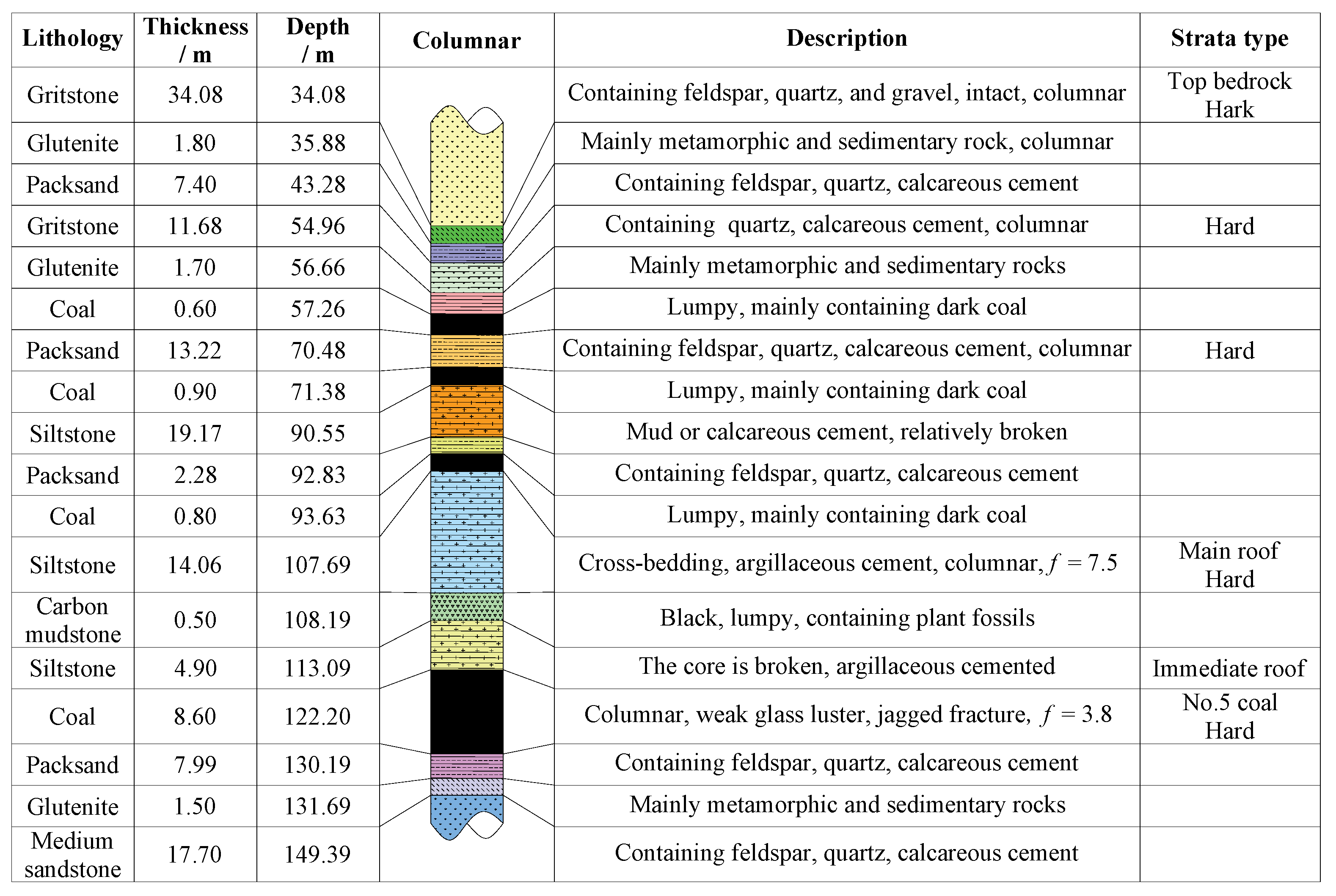






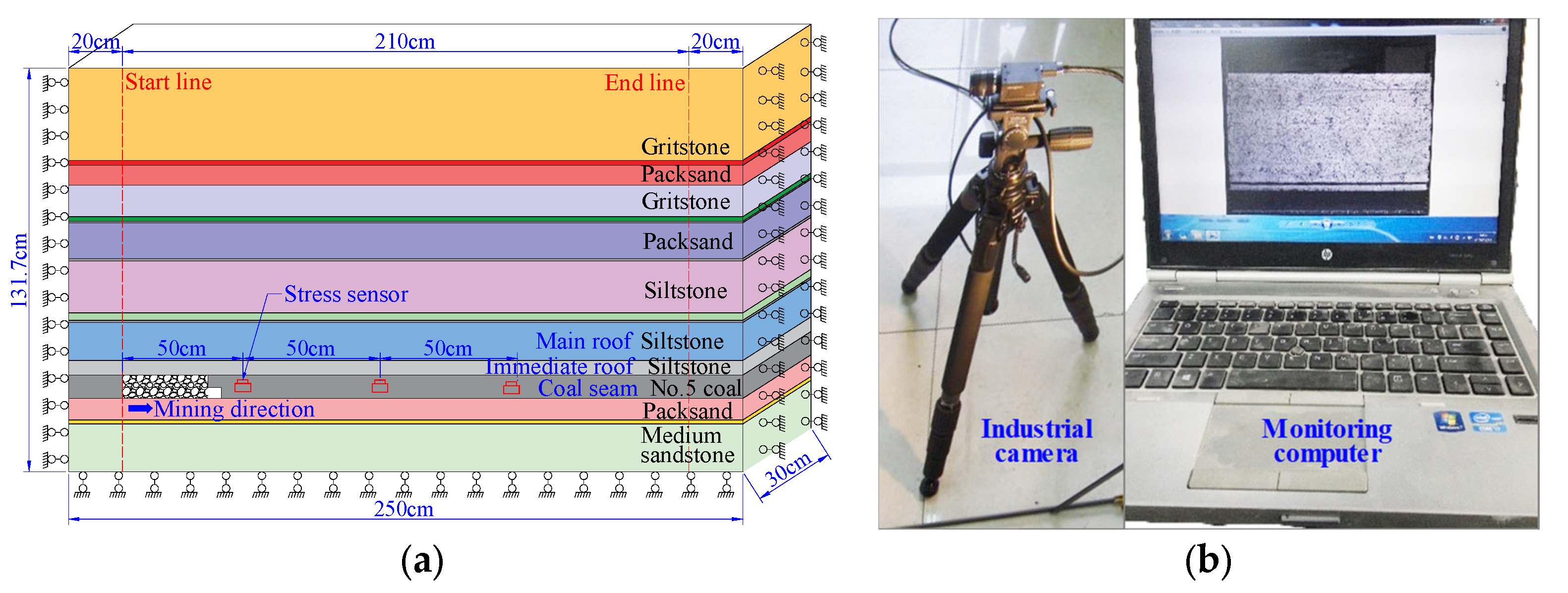


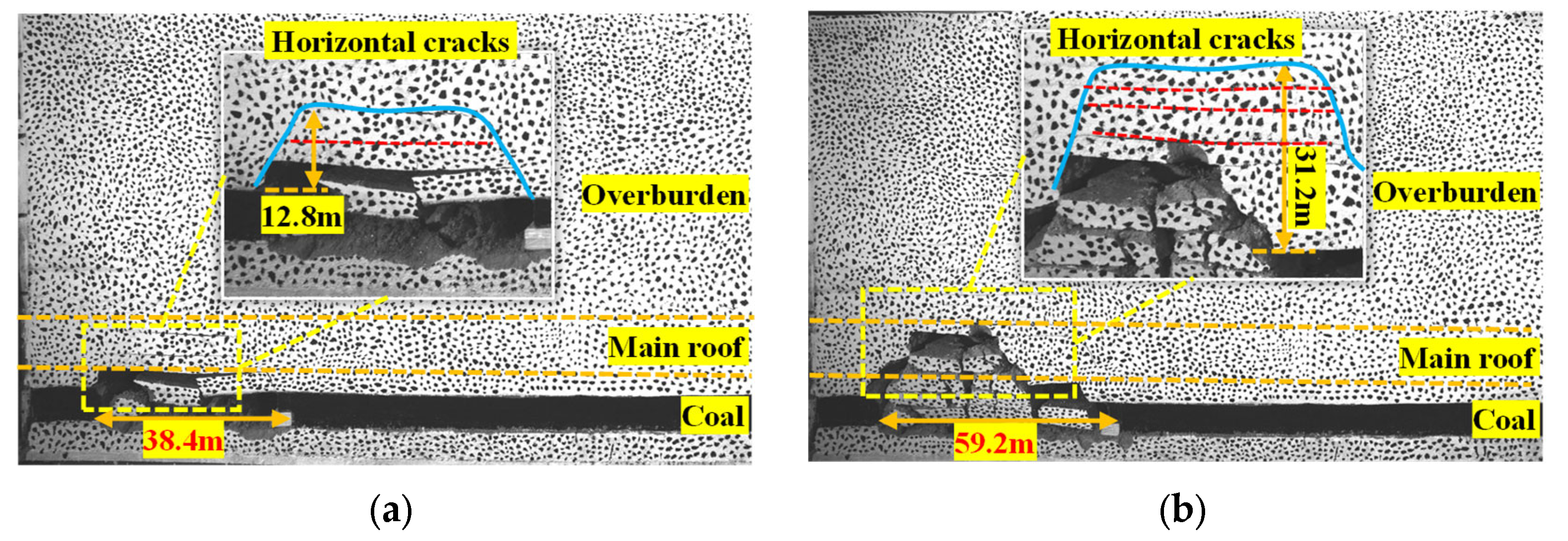

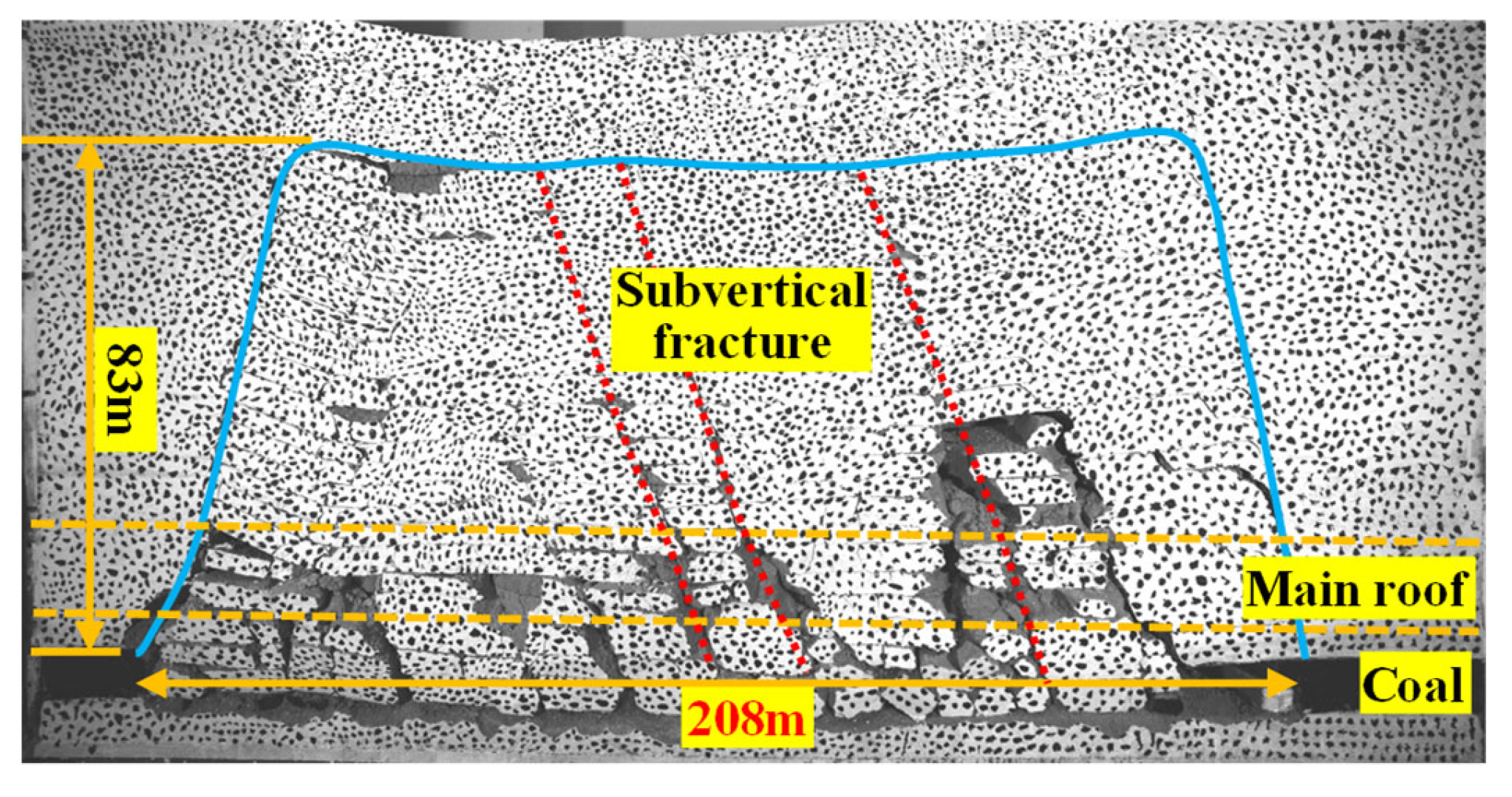


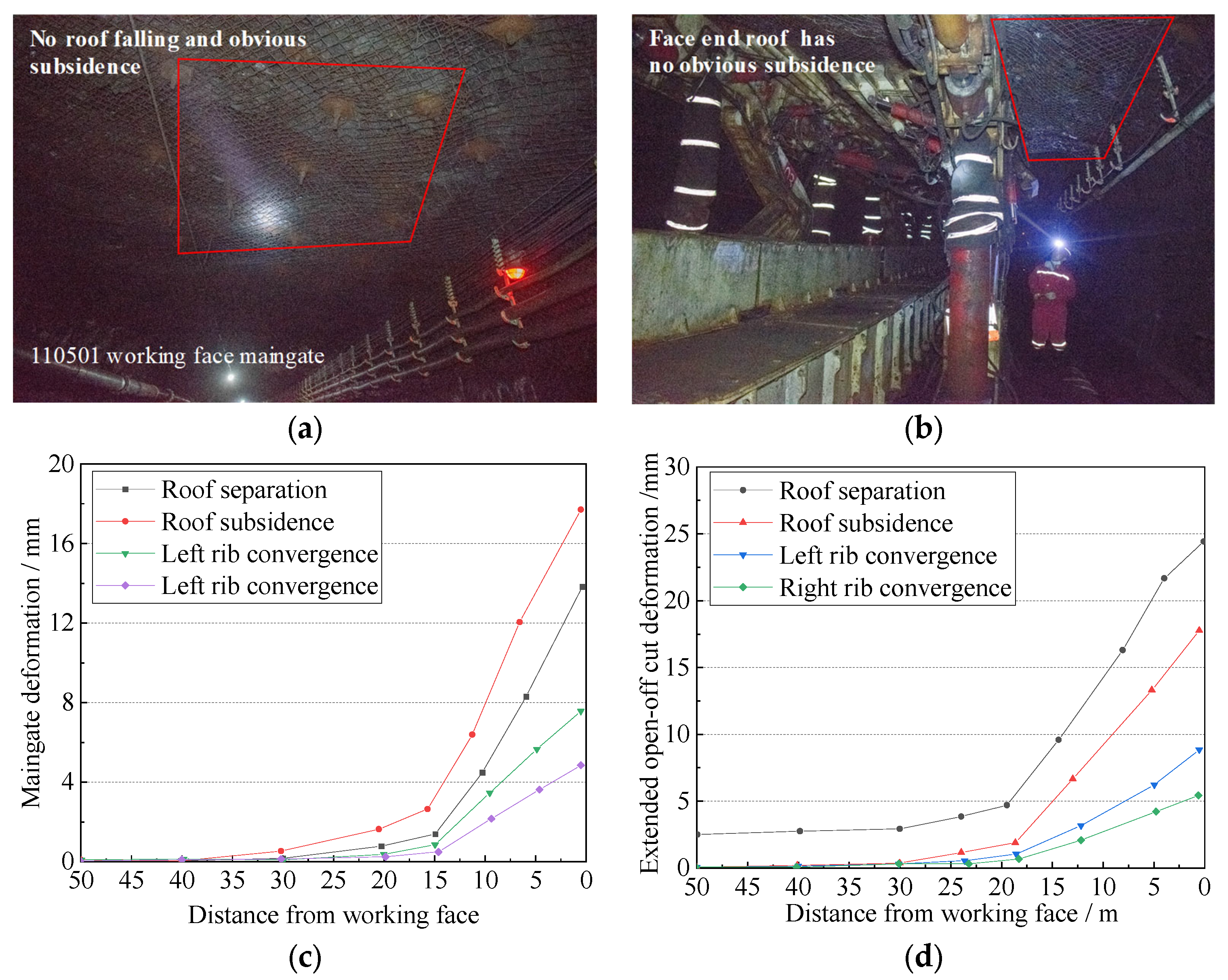
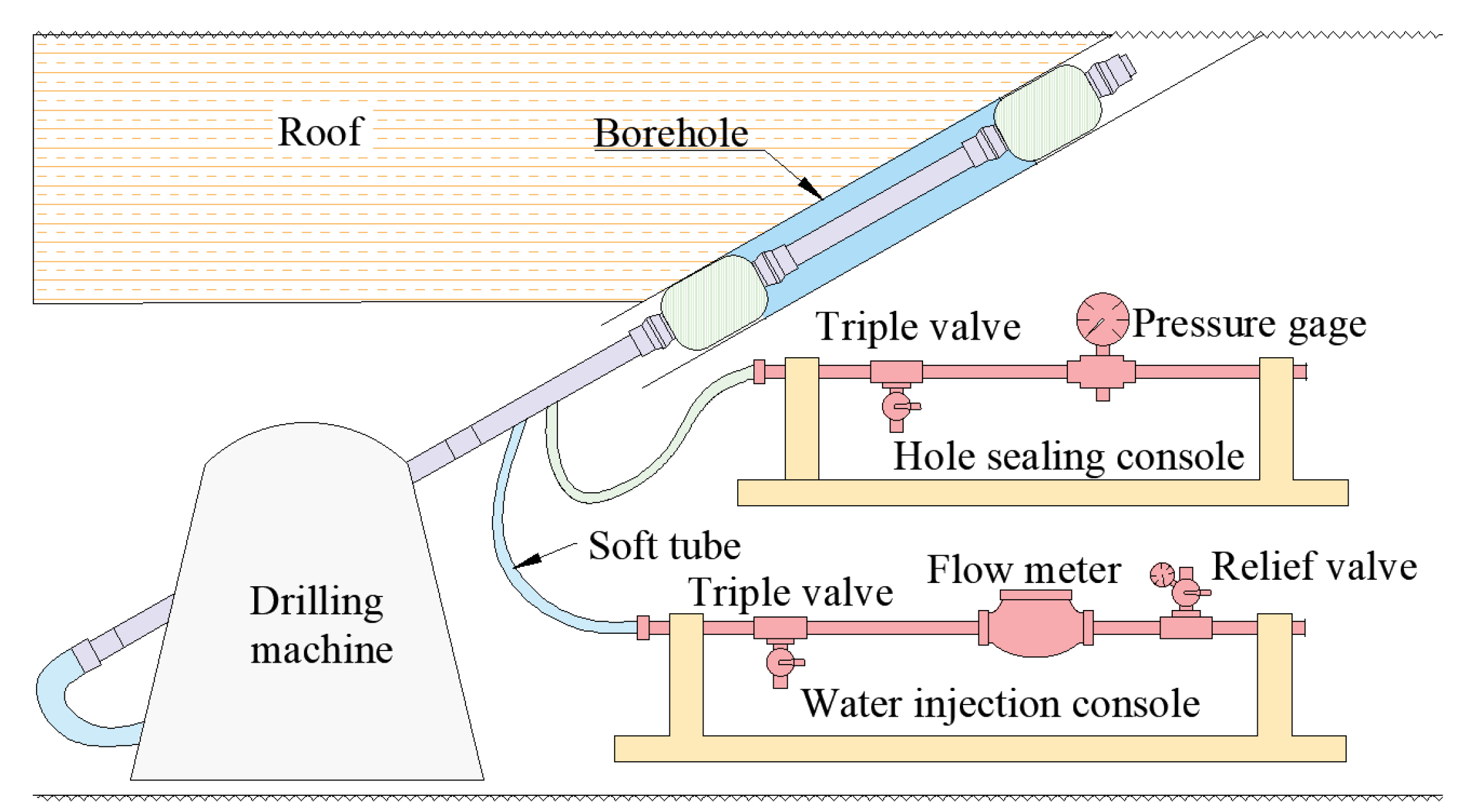
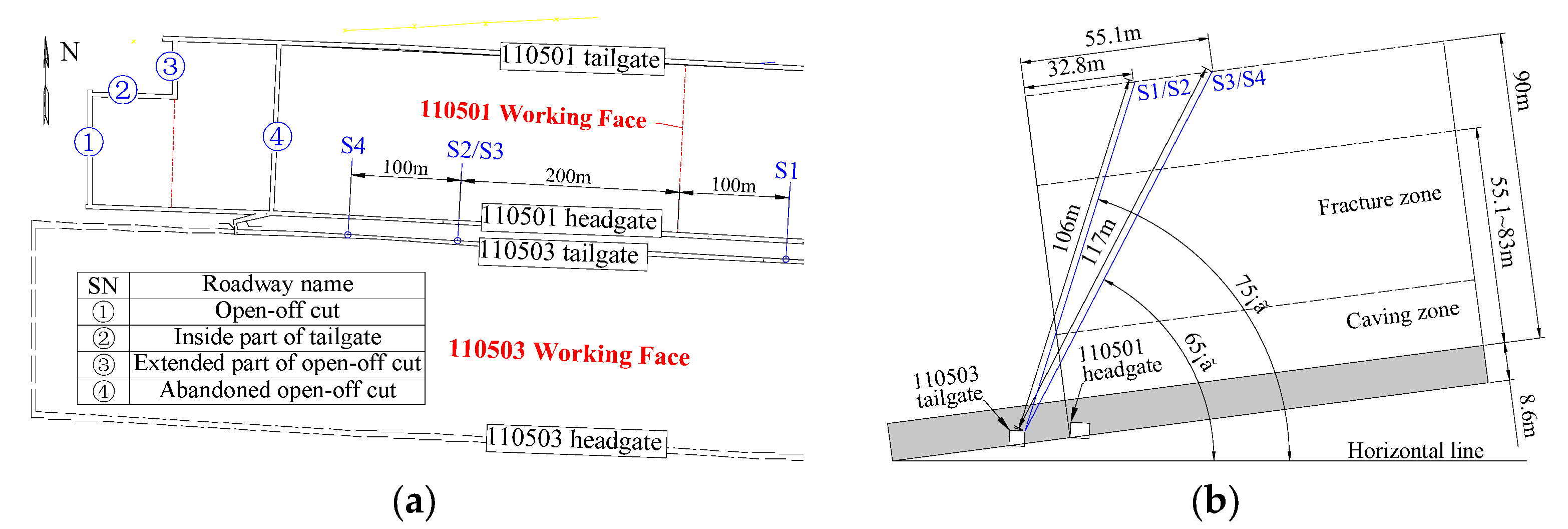
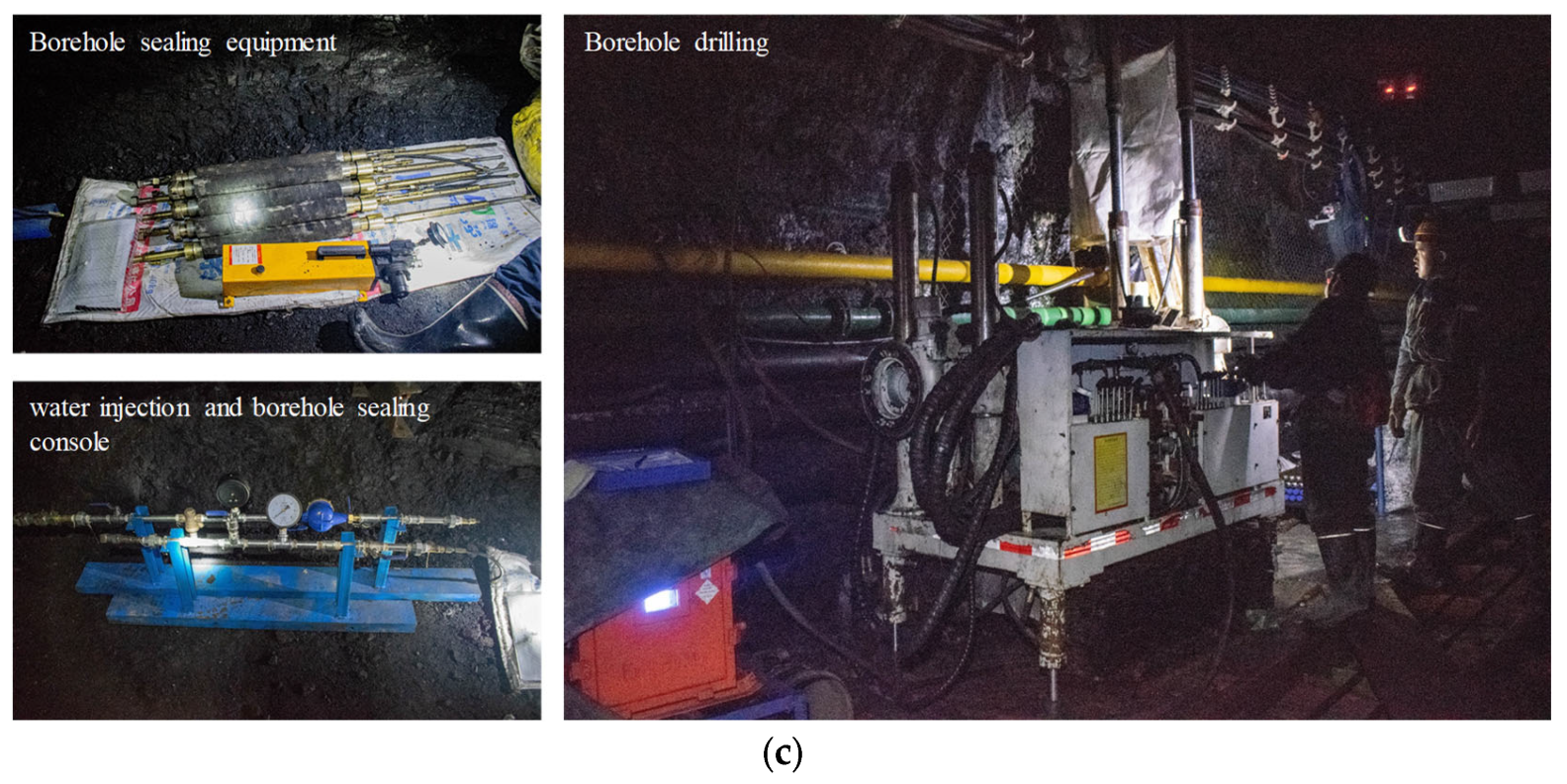
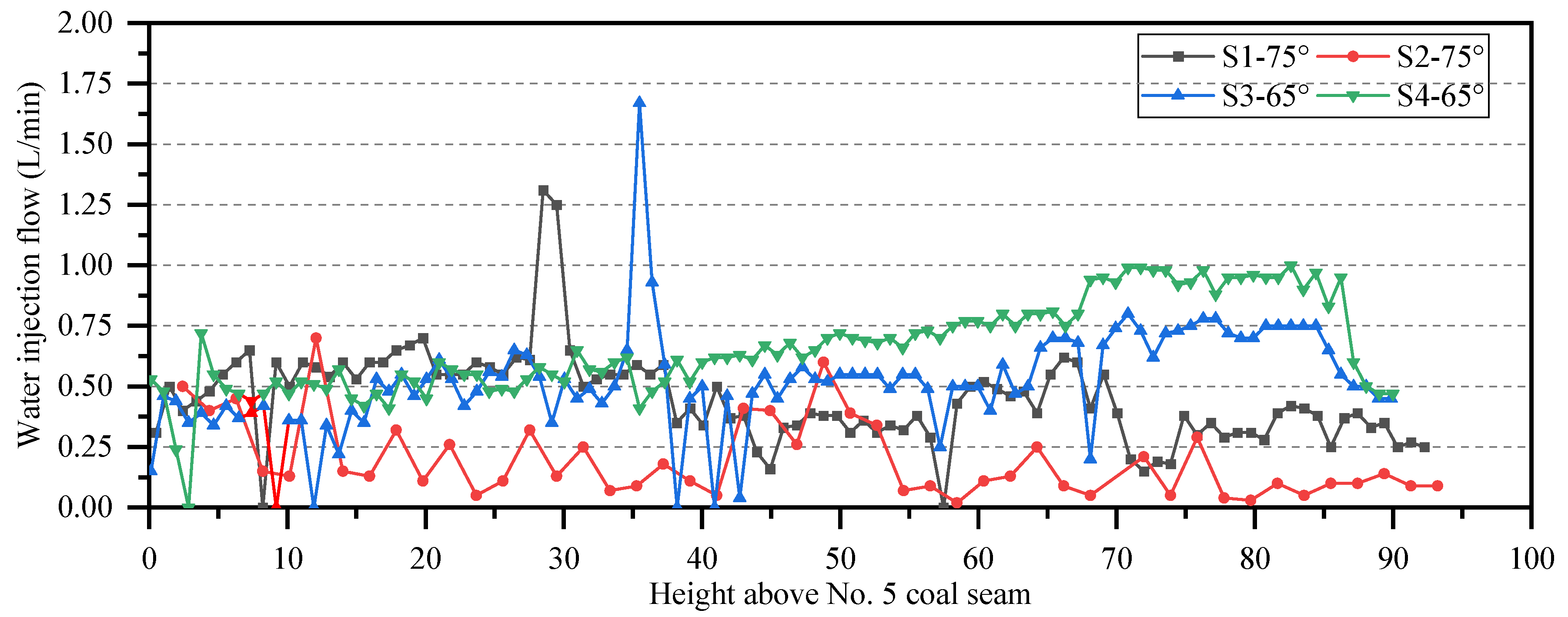
| SN | Lithology | Thickness (m) | Density (kg/m3) | Bulk Modulus (MPa) | Shear Modulus (MPa) | Tension Strength (MPa) | Friction Angle (°) |
|---|---|---|---|---|---|---|---|
| 1 | Gritstone | 34.08 | 2490 | 2679 | 1764 | 1.49 | 43.15 |
| 2 | Glutenite | 1.80 | 2540 | 2886 | 1901 | 1.72 | 39.6 |
| 3 | Packsand | 7.40 | 2630 | 2643 | 1820 | 1.46 | 40.23 |
| 4 | Gritstone | 11.68 | 2490 | 2679 | 1764 | 1.49 | 43.15 |
| 5 | Glutenite | 1.70 | 2540 | 2886 | 1901 | 1.72 | 39.6 |
| 6 | Coal | 0.60 | 1350 | 2139 | 1204 | 0.78 | 48.23 |
| 7 | Packsand | 13.8 | 2630 | 2643 | 1820 | 1.46 | 40.23 |
| 8 | Siltstone | 19.17 | 2660 | 3550 | 2345 | 1.38 | 39.6 |
| 9 | Packsand | 2.28 | 2630 | 2643 | 1820 | 1.46 | 40.23 |
| 10 | Coal | 0.80 | 1350 | 2139 | 1204 | 0.78 | 48.23 |
| 11 | Siltstone | 14.06 | 2660 | 3550 | 2345 | 1.38 | 39.6 |
| 12 | Siltstone | 5 | 2660 | 3550 | 2345 | 1.38 | 39.6 |
| 13 | No. 5 coal | 8.6 | 1350 | 2139 | 1204 | 0.78 | 48.23 |
| 14 | Packsand | 7.99 | 2630 | 2643 | 1820 | 1.46 | 40.23 |
| 15 | Glutenite | 1.50 | 2540 | 2886 | 1901 | 1.72 | 39.6 |
| 16 | Medium sandstone | 17.70 | 2630 | 2643 | 1820 | 1.46 | 40.23 |
| Advance Distance | 60 m | 155 m | 270 m | 370 m | |
|---|---|---|---|---|---|
| Abutment Pressure | |||||
| Front abutment pressure | Peak stress | 2.9 | 3.4 | 3.8 | 3.9 |
| Peak stress distance from working face | 6 | 8 | 9 | 10 | |
| Influence distance | 12 | 16 | 18 | 19 | |
| Side abutment pressure | Peak stress | 2.8 | 3.8 | 4.0 | 4.1 |
| Peak stress distance from working face | 5 | 9 | 10 | 11 | |
| Influence distance | 10 | 16 | 19 | 21 |
| Parameter | Value | Parameter | Value |
|---|---|---|---|
| Model length | 2.5 m | Geometric ratio | 100:1 |
| Model width | 0.3 m | Stress ratio | 167:1 |
| Model height | 1317 mm | Movement ratio | 10:1 |
| Coal seam thickness | 86 mm | Density ratio | 1.667:1 |
| Mining height | 40 mm | Mining step distance | 3.2 m |
| Top coal height | 46 mm | Mining step interval | 30 min |
| SN | Lithology | Sand (kg) | Calcium Carbonate (kg) | Gypsum (kg) | Thickness (cm) | Cumulative Thickness (cm) |
|---|---|---|---|---|---|---|
| 1 | Gritstone | 252.00 | 25.20 | 10.80 | 32.00 | 131.70 |
| 2 | Packsand | 53.28 | 4.00 | 9.32 | 7.40 | 99.70 |
| 3 | Gritstone | 91.35 | 9.14 | 3.92 | 11.60 | 92.30 |
| 4 | Glutenite | 20.25 | 3.38 | 3.38 | 3.00 | 80.70 |
| 5 | Packsand | 102.24 | 7.67 | 17.89 | 14.20 | 77.70 |
| 6 | Siltstone | 129.60 | 21.60 | 21.60 | 19.20 | 63.50 |
| 7 | Packsand | 21.60 | 1.62 | 3.78 | 3.00 | 44.30 |
| 8 | Siltstone | 94.50 | 15.75 | 15.75 | 14.00 | 41.30 |
| 9 | Siltstone | 42.00 | 2.52 | 5.88 | 5.60 | 27.30 |
| 10 | No. 5 coal | 64.50 | 3.87 | 9.03 | 8.60 | 21.70 |
| 11 | Packsand | 57.60 | 4.32 | 10.08 | 8.00 | 13.10 |
| 12 | Glutenite | 24.30 | 4.05 | 4.05 | 3.60 | 5.10 |
| 13 | Medium sandstone | 11.57 | 0.58 | 1.35 | 1.50 | 1.50 |
| Weighting Times | 1 | 2 | 3 | 4 | 5 | 6 | 7 | Mean |
|---|---|---|---|---|---|---|---|---|
| Pressure/MPa | 29.5 | 30.9 | 30.0 | 31.5 | 32.0 | 32.2 | 32.2 | 30.8 |
| Dynamic factor | 1.08 | 1.13 | 1.13 | 1.10 | 1.15 | 1.16 | 1.16 | 1.11 |
| Weighting distance/m | 33.5 | 26.3 | 25 | 26 | 27 | 25.6 | 25.6 | 25.8 |
| Borehole Name | Diameter | Angle | Length | Height | Distance from 110501 Face | Type |
|---|---|---|---|---|---|---|
| S1 | 75 mm | 75° | 117 m | 90 m | 100 m ahead | Control borehole |
| S2 | 75 mm | 75° | 117 m | 90 m | 200 m behind | Observation borehole |
| S3 | 75 mm | 65° | 117 m | 90 m | 200 m behind | Observation borehole |
| S4 | 75 mm | 65° | 117 m | 90 m | 300 m behind | Observation borehole |
Disclaimer/Publisher’s Note: The statements, opinions and data contained in all publications are solely those of the individual author(s) and contributor(s) and not of MDPI and/or the editor(s). MDPI and/or the editor(s) disclaim responsibility for any injury to people or property resulting from any ideas, methods, instructions or products referred to in the content. |
© 2024 by the authors. Licensee MDPI, Basel, Switzerland. This article is an open access article distributed under the terms and conditions of the Creative Commons Attribution (CC BY) license (https://creativecommons.org/licenses/by/4.0/).
Share and Cite
Wu, Z.; Sun, Q.; Wang, Y. Evolution Laws of Water-Flowing Fracture Zone and Mine Pressure in Mining Shallow-Buried, Hard, and Extra-Thick Coal Seams. Appl. Sci. 2024, 14, 2915. https://doi.org/10.3390/app14072915
Wu Z, Sun Q, Wang Y. Evolution Laws of Water-Flowing Fracture Zone and Mine Pressure in Mining Shallow-Buried, Hard, and Extra-Thick Coal Seams. Applied Sciences. 2024; 14(7):2915. https://doi.org/10.3390/app14072915
Chicago/Turabian StyleWu, Zhongya, Qiang Sun, and Yunbo Wang. 2024. "Evolution Laws of Water-Flowing Fracture Zone and Mine Pressure in Mining Shallow-Buried, Hard, and Extra-Thick Coal Seams" Applied Sciences 14, no. 7: 2915. https://doi.org/10.3390/app14072915
APA StyleWu, Z., Sun, Q., & Wang, Y. (2024). Evolution Laws of Water-Flowing Fracture Zone and Mine Pressure in Mining Shallow-Buried, Hard, and Extra-Thick Coal Seams. Applied Sciences, 14(7), 2915. https://doi.org/10.3390/app14072915






